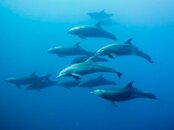Wossa I don't know the camera however you have the option to shoot RAW and JPEG at same time. I guess you only shot RAW?
Anyway a good explanation of image noise has been posted by Maria
Now what that does is to create bands of colour, especially when you shoot in the middle of the blue water
Looking at your single dolphin if you display at original size you notice two things:
1. Grains in the blue (luminance noise the images do not have coloured dots as chroma noise would have)
2. When you actually look at the dolphins themselves all the edges look badly ragged. So the picture looks fine when is small but at original size they are quite ugly
This may be down to the processing as in RAW the camera does no sharpening. Can you email me the source picture or put it on dropbox?
Anyway a good explanation of image noise has been posted by Maria
Now what that does is to create bands of colour, especially when you shoot in the middle of the blue water
Looking at your single dolphin if you display at original size you notice two things:
1. Grains in the blue (luminance noise the images do not have coloured dots as chroma noise would have)
2. When you actually look at the dolphins themselves all the edges look badly ragged. So the picture looks fine when is small but at original size they are quite ugly
This may be down to the processing as in RAW the camera does no sharpening. Can you email me the source picture or put it on dropbox?
Thanks Interceptor, great feedback, really appreciate it. I think the majority of my problems are simply down to the fact I am not really sure what I am doing, especially with processing. I shot in RAW, but then realised my LR3 is not compatable with the G1 X raw files, so had to then convert to JPeg. Might sound like a really dumb question, what exactly is luminance noise, and how can I identify it in the images ? Really appreciate any pointers.....





